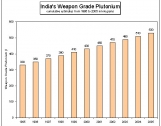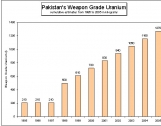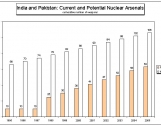Reports
Fact Sheet: India and Pakistan—Current and Potential Nuclear Arsenals
by David Albright
May 13, 1998
The decision by India to conduct five nuclear tests in May 1998 threatens to spark an all-out nuclear arms race between India and Pakistan. Both India and Pakistan have developed the capability to produce unsafeguarded weapon-grade plutonium and weapon-grade uranium (WGU) for nuclear weapons. However, until now, both countries have constrained their nuclear competition, preferring to keep their arsenals undeployed. In addition, Pakistan decided in the early 1990s to stop producing weapon-grade uranium, in essence capping its stock of material for nuclear weapons.
India is widely perceived to have a significantly larger nuclear arsenal than Pakistan. The following estimate shows that if a nuclear arms race developed between India and Pakistan and Pakistan decided to resume WGU production, India’s overwhelming advantage could disappear.
ISIS estimates that India has about 370 kilograms of weapon-grade plutonium, or the equivalent of about 74 nuclear weapons. India relies principally on the Dhruva reactor for weapon-grade plutonium, and can increase its stock of weapon-grade plutonium at a rate of about 20 kilograms per year. This amount corresponds to roughly four nuclear weapons per year. At this rate, in 2005 India is estimated to have enough weapon-grade plutonium for over 100 nuclear weapons.
India could produce significantly more weapon-grade plutonium by using its CANDU power reactors, although it may not have sufficient facilities to separate significant quantities of plutonium from the irradiated CANDU fuel.
When Pakistan froze its production of weapon-grade uranium in 1991, it had produced an estimated 210 kilograms at the Kahuta gas centrifuge uranium enrichment facility. At roughly 20 kg of weapon-grade uranium per weapon, this is enough material for about 10 weapons. As of early 1998, Pakistan is not known to have resumed the production of HEU.
Since 1991, Pakistan is believed to have produced low enriched uranium (LEU) there. If Pakistan decides to resume its production of WGU, it would likely use its stock of LEU to produce WGU more quickly. If the enrichment output of the Kahuta plant remains fixed, Pakistan could produce about 300 kg of weapon-grade uranium during the first year by utilizing its LEU as “feed” for Kahuta. In subsequent years, Pakistan is estimated to be able to produce about 110 kg/yr of weapon-grade uranium, using natural uranium feed. In 2005, Pakistan is estimated to have enough weapon-grade uranium for over 60 nuclear weapons. In addition, in April 1998 Pakistan commissioned an unsafeguarded reactor that is capable of producing about 10-15 kg/yr of weapon-grade plutonium, or enough for about 2-3 nuclear weapons per year. However, this output is not considered here. Pakistan also could significantly increase Kahuta’s output, but this possible action is similarly not considered.
Although India is estimated, as of early 1998, to possess seven-times more nuclear weapons than Pakistan, the table shows that Pakistan could reduce that margin to a factor of less than two over the next eight years. If India wanted to maintain a significant lead over Pakistan, it would be forced to dramatically increase its fissile material production. Pakistan, however, is capable of matching such an increase.
Table: India’s and Pakistan’s cumulative projected fissile material stocks and nuclear weapons potential
| India | Pakistan | |||||
| End of … | WGPu* | # of weapons | WGU** | # of weapons | ||
| 1995 | 330 | 66 | 210 | 10 | ||
| 1996 | 350 | 70 | 210 | 10 | ||
| 1997 | 370 | 74 | 210 | 10 | ||
| 1998 | 390 | 78 | 500 | 25*** | ||
| 1999 | 410 | 82 | 610 | 30*** | ||
| 2000 | 430 | 86 | 720 | 36*** | ||
| 2001 | 450 | 90 | 830 | 41*** | ||
| 2002 | 470 | 94 | 940 | 47*** | ||
| 2003 | 490 | 98 | 1,050 | 52*** | ||
| 2004 | 510 | 102 | 1,160 | 58*** | ||
| 2005 | 530 | 106 | 1,270 | 63*** |
- Weapon-grade plutonium, in kilograms ** Weapon-grade uranium, in kilograms *** Assumes HEU production resumes in early 1998.
Also see:
ISIS Estimates on India’s Weapons Grade Plutonium 1995-2005
For additional information, contact ISIS at (202) 547-3633.




 twitter
twitter